From Kings Canyon I turned south. After the morning hike it was a late start to the day so I decided to ride on into the night. I knew I’d reach a rest area a couple hours after dark and I fancied covering some extra distance out of the awful sun.
The last hour of light is the most magical of the day. The evening sun throws an orange tint across the outback making the landscape look warm and inviting. The millions of stars usually twinkle so bright that it never actually gets that dark but this night was different – thick cloud filled the sky in the late afternoon and once the last light had trickled away it was incredibly dark.

For the very first time I felt uneasy about the emptiness of the outback. It’s strange that it takes darkness (when everything is hidden) for the scale of things to really hit me. The air was pleasantly cool but the quiet unnerving. The animals hit the sack after dark, just like me. Now it was just the green glow of spiders’ eyes keeping me company. There were no cars at all. I was alone, cycling through the night past miles and miles of nothing. I was relieved when I finally reached the rest area.
I woke before it was light because a dingo was sniffing around my tent. I got out and threw rocks at it but the dog didn’t seem to care – it kept running over to the rocks once they’d stopped bouncing to see what they were. As I went back to bed I switched on my head-torch and saw, to my horror, that my tent had been overrun by ants. There were millions of them inside.

I’ve complained plenty about flies in the last two blogs. Just assume that they’re driving me to the brink of insanity every day out here. In this blog I’m going to complain about the ants instead:
I thought the ants could never be as much a pain as they had been in SE Asia. I was wrong. The outback is covered in them and they are every bit as annoying as the flies. Any drop of food and water and they will be swarming the place in seconds. If I find a bad place to pitch I can’t get out for a wee in the night without having my legs covered in them by the time I get back into my tent.
On this occasion I hadn’t realised that I’d camped on an area covered in ants. I should have known – they love the rest areas. I also hadn’t realised that I’d left my tent door zips a couple of centimetres open and that was just enough for the ants to invite themselves in for the pyjama party.
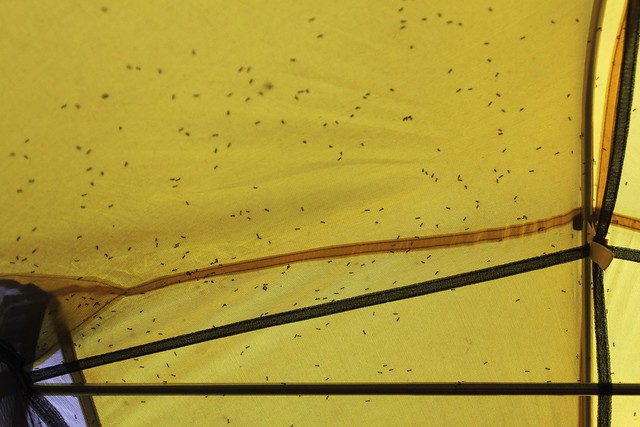
I couldn’t go back to sleep so packed up whilst waiting for the first light to break. I’m used to being super careful with food in ant-country but it’s the water they love here. Another night I’d left my thermos outside the tent. The lid is slightly broken so there’s always a tiny slit open. When I opened it later in the day for a drink I spotted (just in time) that the inside was full of a thousand drowned ants before I put the flask to my lips.
The dingo was still loitering around the camp. They’re not stupid animals, those things. They know there’s an easy feed when picnic-ing humans are around. This one kept on returning to the water tank every time I turned it on to lick up from the pool left behind. Then it came following me around and starting cocking its head and snarling until I chased it away with a stick. If dingos get used to humans they’ll see them as pack members but they act aggressively to members of their own pack. I don’t fancy a dingo for a friend.
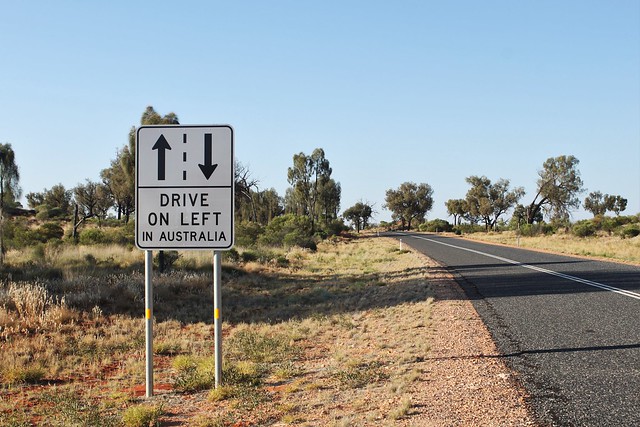
Once I hit the Lesseter road I turned west. Australia’s most iconic landmark was only a couple hundred miles away and the detour to visit it was one I was prepared to make.
My heart jumped when I finally I saw it. The ‘rock’.

At least, I thought I saw it. I had fallen foul of the Red Centre’s famous red herring. This was not the rock. It was Mt Connor – an impressive sight but not the one I’d come all this way for.

The next day I stopped to talk to a man standing by a dusty two wheel drive miles from anywhere. He’d run out of fuel and was waiting for someone to return from the nearest roadhouse with petrol for him.
“Why didn’t you fill up at Yulara?” I asked him.
“Ain’t got any money ‘till tomorrow” he replied as if it was a stupid question.
The poor bloke was waiting under a solitary tree waving a branch continuously across his face to keep the flies off. We chatted for a while and it quickly became apparent that he had a screw loose. I suppose anyone taking their chance in the outback with a few drops of petrol in the tank is probably a bit loopy but I realised it as I tried to keep up with bizarre flow of conversation. One minute he was talking about the logistics of sailing around the world (I suggested that it might be a little bit more difficult than cycling but he reckoned you could easily wing it), then he was telling me about how to solve the migrant crisis in Europe (his solution was something along the lines of ‘just tell ‘em all to fuck off!’) and then wanted to know where I would build a new mega city in Australia if I had to choose a spot.
I excused myself from the conversation.
“Hey mate, you wanna beer?”
“Maybe not right now…”
“Take it for later”
“It’ll be boiling!”
“Nah mate, what you do is – you take a sock off, wet it, stick the bottle in it and hang it off a tree. In half an hour you’ll have a cold beer.”
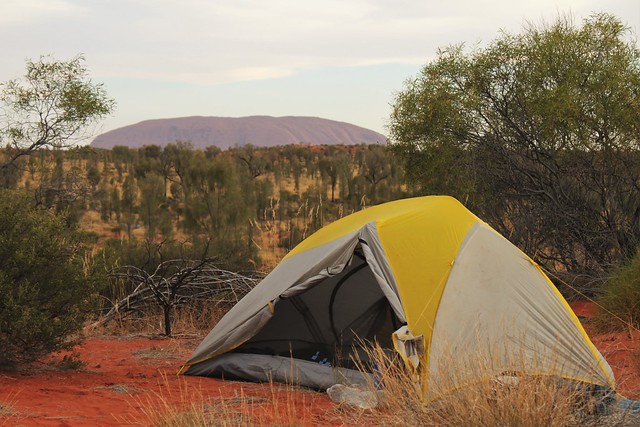
I climbed up onto a red sand dune a couple of hours later and here it was. The actual rock. Uluru in all her beauty. I pitched my tent on top of the dune feeling very chuffed. Now I had a beer to celebrate the occasion with! (The sock trick didn’t work but I had a tiny bit of ice left in my thermos so I could even have a cold one).
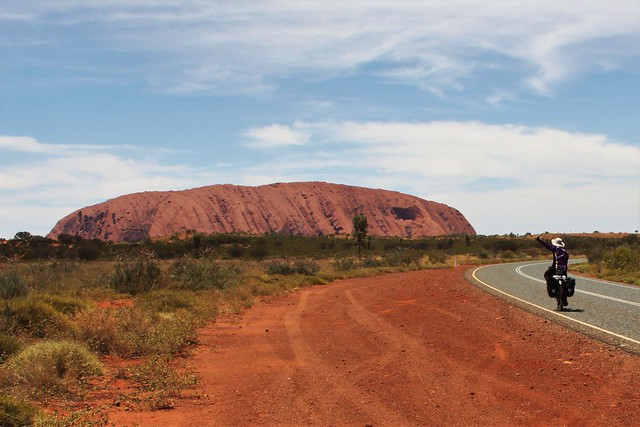
Before arriving in Australia I had no idea what the aboriginal name is for Ayre’s Rock. I’d not even considered the fact that it might have an indigenous name. I now know it’s Uluru and seeing as that’s what it’s referred to over here I’ll stick with that PC name.
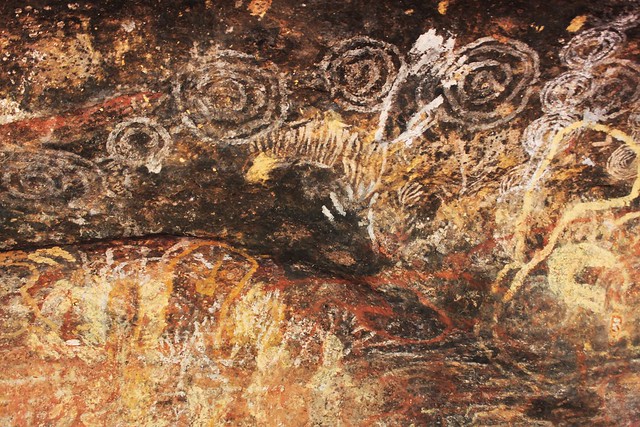
To be honest – I only went over to the rock because I felt obliged. It is a long detour on a bicycle and I only went there because there’s so few other ‘sights’ out here. I felt surprisingly proud of myself as I watched the sunrise from my tent, the first rays of light illuminating the distant rock. Proud of having reached one of the world’s most iconic spots on the other side of the planet. That’s all it was to me – a tick off the tourist checklist. I was more excited about visiting the resort’s supermarket (having not seen a proper shop since Alice Springs over a week ago).
It was only when I drew closer and cycled around the rock that I saw what a special place it is. Or rather, felt what a special place it is. There is something quite extraordinary about that big boulder. Especially knowing how many hundreds of miles of flat desert surrounds it. I should know – I’ve cycled for weeks through more of less nothing. I wonder if it’s the same feeling for the tourists who drive down from Darwin or up from Adelaide. I wonder if it’s the same feeling for the tourists who get a bus over from Alice Springs. I wonder if it’s the same feeling for the tourists who arrive at the rock by aeroplane. I doubt it, somehow.
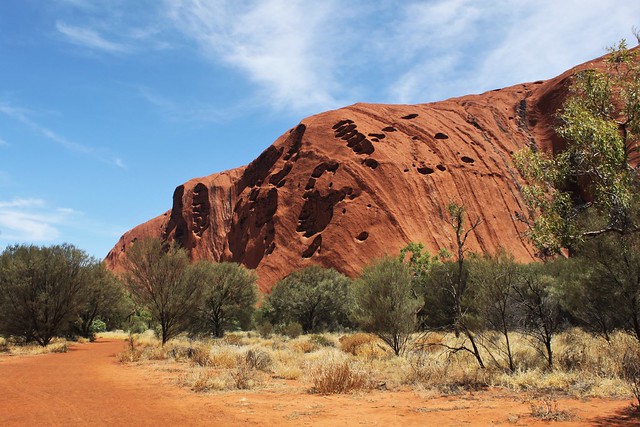
Even a cynical non-believer like myself can’t deny the fact there’s a numinous edge to that place. I like to think that God got bored on the 7th day and thought ‘ah fuck it – I’m just gonna drop a rock from Mars down on Earth and see how many thousands of years it takes the humans to make it a sacred place and then a tourist attraction.
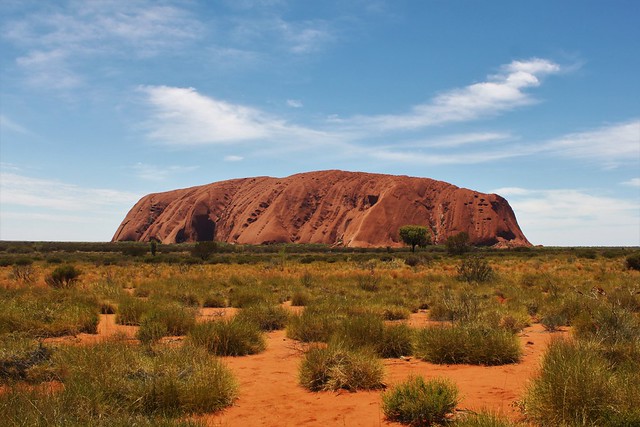
It’s not been a tourist attraction long, really. It was discovered less than 150 years ago and has only receiving tourists since the 50s. It must be strange for the oldest locals who saw the very occasional white person come hiking through the bush to find this mysterious rock to what it is now: a million-dollar attraction drawing tourists from all around the world.
I had no idea you could climb up onto the top of the rock until I came to Australia and heard people debate about whether or not it should be allowed. There are signs all over the national park saying: “the local aboriginal community ask that you kindly do not climb on our sacred place” and yet the park authorities don’t actually close it. I’m not really sure why. Perhaps they worry that less tourists will come if they know they’re not allowed up on the rock. Instead they make up a million excuses to close the hike: in the hot summer months it’s only open before 8am if there’s no chance of rain, they rock isn’t wet, it’s not at all windy etc.

I find it strange that people still climb the rock knowing it’s disrespectful to the local people. I’d love to climb up it but all I need is to be asked politely and I won’t. If a Muslim invited me to his home I wouldn’t start frying bacon for breakfast in the morning. It’s for the same reason that I take my hat off when I enter a church. Respect costs nothing.
After a lap around Uluru I cycled over to Kata Jtuta (The Olgas) 40km ‘just down the road’. You can see them from many miles away. The horizon is broken only by the neat symmetrical curves of Uluru and in the distance the random slumps of Kata Tjuta – the ugly next door neighbour.
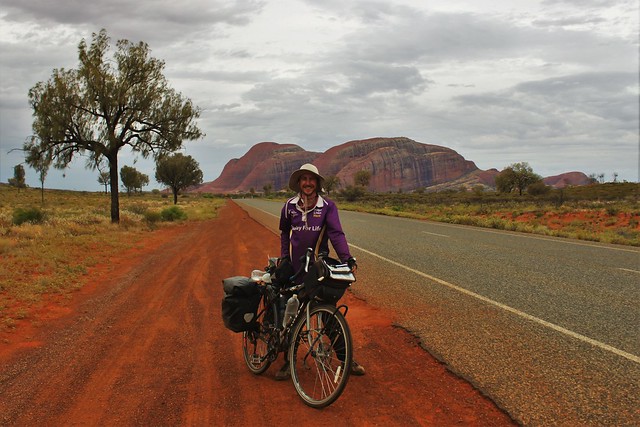
I skipped the no-camping signs and pitched behind some trees ready to hike around Kata Tjuta in the morning. The Valley of The Winds hike was a stunning stroll through the surreal giant rock formations. I had much more fun exploring Kata Tjuta than Uluru.
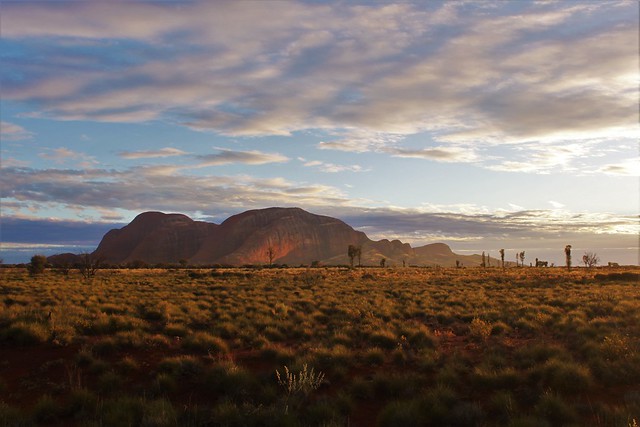

I took a deep breath when I got back to my bike. This was the end of the long dead-end. I now had to cycle 190km back along the very same road to where I’d joined the Lasseter Highway. The wind was waiting for me, blasting in my face with all her might. The next few days cycling east where spent screaming in frustration into horrendous and unrelenting headwinds.
I had one very pleasant suprise to take my mind off the wind. On my way out of the Ayre’s Rock Resort area I returned to my red-dune campsite from a couple nights back. There were some trees hiding a cleared area away from the road just a couple miles up from where people were paying $30 a night to camp in the resort. It seemed I wasn’t the only one to have found such a convenient free-camp. Some American tourists were already making themselves at home when I arrive.
“You fancy joining us for dinner? It’s Thanksgiving today…”
And so I celebrated my first ever Thanksgiving – in the Australian outback of all places!
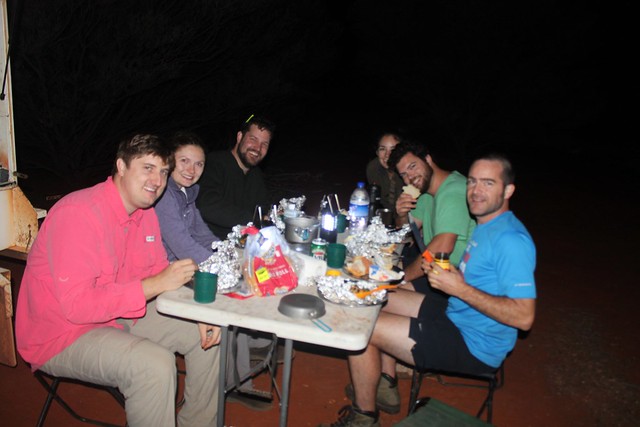
I was crawling eastwards in the winds. It took forever, which meant I had even more time to think. I do a little too much thinking in the outback, but there’s not too much else to do out here. I thought about the aboriginal ‘problem’ – the very subject I’ve thought about more than anything in Australia. It’s a problem that I didn’t even know existed until I came here.
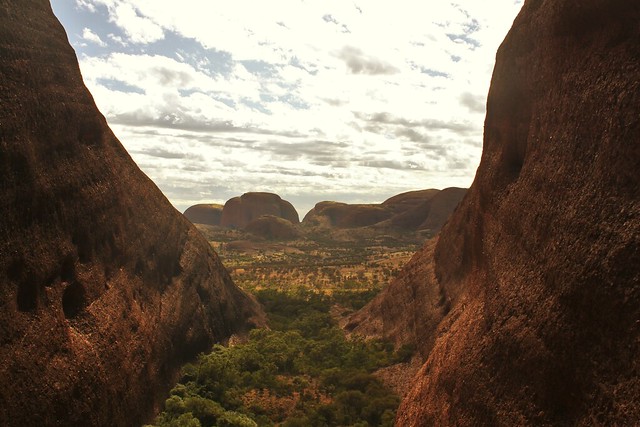
The Uluru National Park is well presented – it’s co-owned between the National Park and the local community (the land is Aboriginal owned but leased to the Park) and there are many signs about the aboriginal beliefs surrounding the rocks. There is aboriginal art in for sale in the visitor centres and locals in traditional body paint doing small shows about how to make hunting weapons. You could easily come to just this part of the outback (as indeed many tourists do) and go home thinking ‘ah, how nice and integrated the white and blacks are here. It’s great how they value each others respective culture’. How wrong they would be…
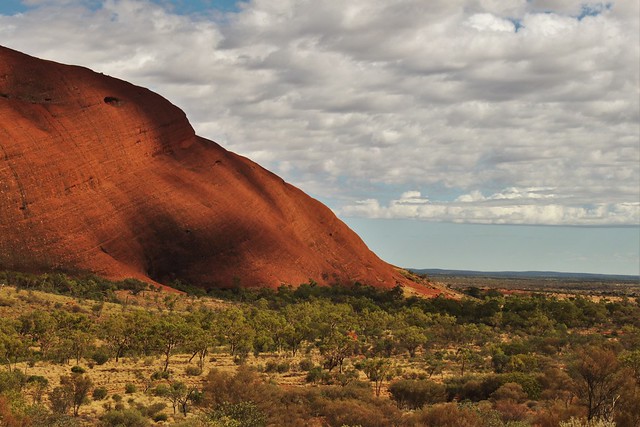
What I have seen in the Northern Territory is deeply unsettling. The divide between ethnic groups is perhaps more obvious than anywhere I have ever been. The gap in social standards is startling – the aboriginal community has terrible statistics to show about alcoholism, unemployment, health etc. I stayed with health workers in a couple of places who worked in aboriginal communities who told me that they were working on illnesses that you would never see in another ‘developed’ nation, but they are health issues that affect the black community alone here.
I don’t really feel qualified to talk about this subject because I don’t really understand it. I will try though, because it’s something we should be thinking about. The issue is this: White people haven’t been here very long at all. There were still aboriginals walking out the bush in the 1980s who hadn’t seen white people! (See the Pintupi Nine). You have two very different world systems placed right on top of each other that simply don’t match up. The aboriginals have a very different sense of ownership. They seem themselves and their positions in the world very differently. Money is treated different too.
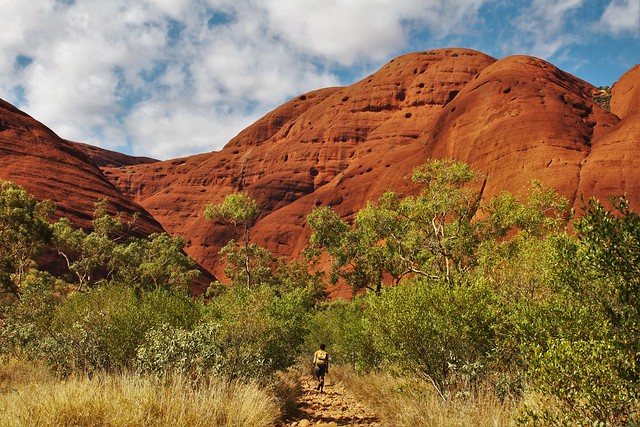
I’ve seen very few aboriginals working a ‘normal’ job. In their communities you’ll find white people running the general store. White people teaching the school. White people doing health care. I was told one story about an aboriginal girl who was working in the local shop. All her family knew the day she got paid and as soon as the money went into her account, they knew her details and had taken it out already. It was for sharing among the family – not for one person to stash alone.
Alcoholism has caused so much trouble in the communities (although it’s a problem across the board in many places up here). I now see where the stereotypes come from. I saw my first aboriginals when I was cycling into Darwin from the airport. They were blind dunk at 10am and my heart sank a little that the stereotype I’d been told by so many Aussies was playing out so quickly before my eyes. The thing is, if you’re somewhere where aboriginals are the minority then there’s a good chance they’ve gone there for the booze. In some cases the people with alcohol problems have been kicked out of their community and they’ve just gone to town to get drunk. Most of the aboriginal communities I’ve passed have been dry (elected to be so themselves). There are often Alcohol free signs at the settlement entrances.
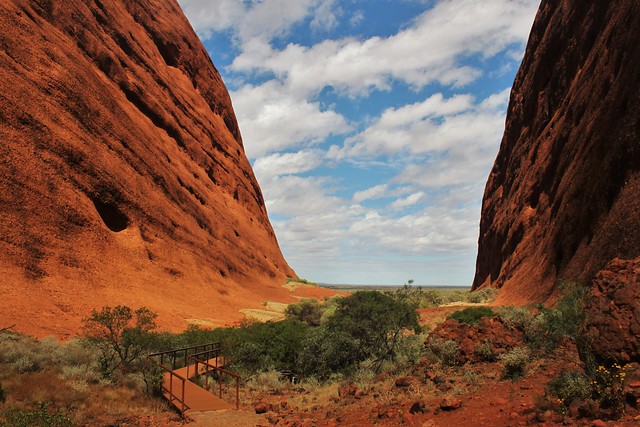
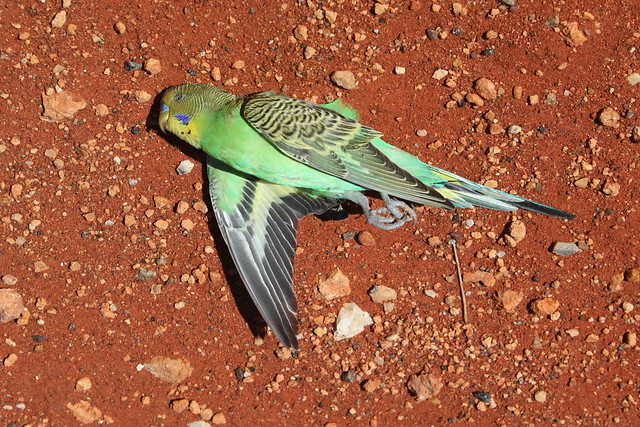
I wanted to head south through the APY lands but I’d never have got a permit to travel through the aboriginal land. I found it very strange at first that in Australia there are areas ‘off limits’ to me. Am I back in Myanmar? I’d planned on heading along the dirt road lining the Northern Territory/South Australia border but with the headwinds I didn’t have the energy for another remote water-less stretch so I continued on the asphalt past Mt Ebenzer – one of the very few aboriginal-owned roadhouses.
I’ve met a few unsavoury characters in the outback (will get onto that in a bit) but every aboriginal I’ve met have been lovely. The funnest conversations I’ve had have been with drunk guys – involving dancing kangaroo tails and stray dingoes on film sets. It’s a shame I’ve not been able to learn more about their traditional lifestyles, it’s something I find fascinating. They are the true masters of this land – if I want to learn about the outback then they are the perfect teachers. Whereas in so many other countries people invited me into their homes and lives, eager to teach me about their lifestyle and values it’s a different story here. I’m just another ‘white fella’. I’m part of the problem.
Part of me could shrug and say ‘it’s not my problem what’s going on on the other side of the world’ but of course, it’s us Brits who started this mess. It was us who deemed the aboriginals as ‘flora and fauna’ making it no problem to take their land as ‘uninhabited by humans’. The way the indigenous people have been wiped from their ancestral land, the way they’ve been forcibly relocated, the way they’ve been degraded, the way colonisers tried to dilute their race and assimilate their people is awful and disgusting. It’s something that should be left to the history books and yet it’s still an issue today.
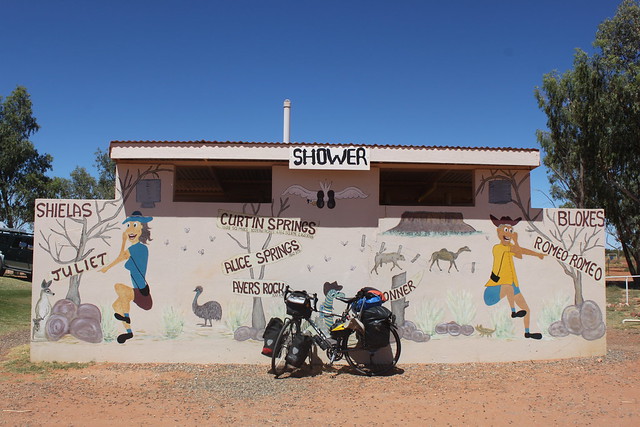
The aboriginal people have been in Australia for 50,000-60,000 years making them one of the oldest ethnic groups in the world. They have not been part of the international trade network for the last few hundred years until the Europeans arrived. A couple hundred years of attempted ‘assimilation’ is nothing when you look at the big picture. It’s like waking up over night and discovering a new world around you. We stick people on reality TV shows in the jungles of Papa New Guinea and laugh at them struggling in a totally new environment. If you took a local person from one of those jungles and dropped them off in London at rush hour the show would be equally entertaining. This is not an unfair metaphor for the 150 years of change in Australia when you appreciate how ingrained our cultural identity is within us.
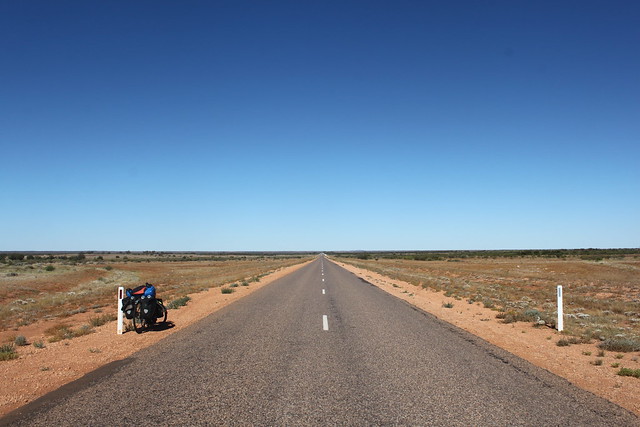
I’ve spent the last two years struggling to integrate in different cultures. We are a product of our environment in ways we don’t even realise. Life in London has changed massively in 150 years and yet the framework of our society has stayed the same. Industry functions in a similar fashion, our homes remain in the same place and our family values are more or less unchanged. The aboriginals were nomadic hunters and gatherers 150 years ago and now live in bland purpose built communities detached from their spiritual land and, as a result, their identity.
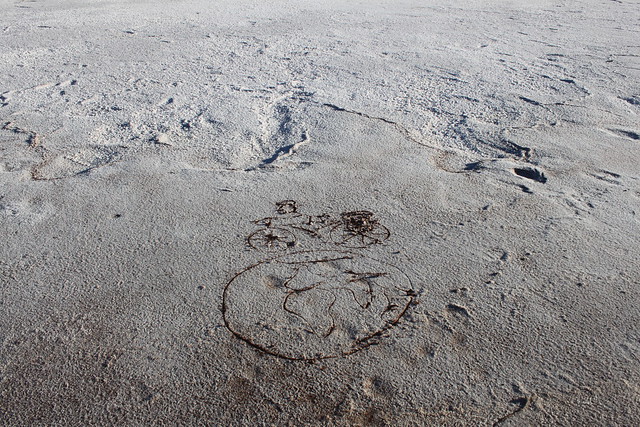
I wonder if modern-day Australia has a problem with empathy. From what I’ve seen here it’s now not that difficult to understand the way they are snatching at East Timors’ oil or sticking refugees on God-forsaken islands. Out of sight, out of mind. I would not pretend that the UK is any better but I have met enough racists in Australia to wonder if this is not a serious problem here.
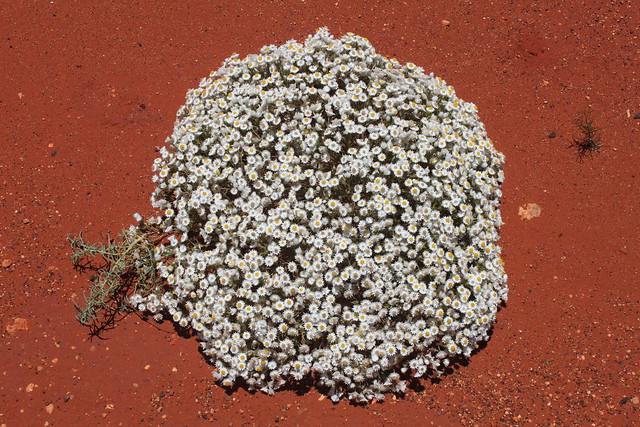
I cycled on into the blasting headwinds but I was barely getting anywhere. My mind continued to drift. Soon the ‘aboriginal question’ became a more broad topic. It raised the issue of how we create society and what we value within it. The adjective ‘primitive’ could be used in describing them, but that p-word conjures all sorts of dangerous connotations. In many ways we, The West, have truly mastered nature. Our lives have progressed so far from how we lived 3,000 years ago. But if you look at it from the other angle – perhaps we have just misunderstood the quality of life. Nothing around us is natural, we eat fake food, live in front of computer screens and don’t even know what the natural world around us looks like. The supermarkets sell us multi-grain healthy ‘natural’ cereal bars because we know that the rest of the food we eat is artificial produce and that we don’t do enough exercise to burn it. What is the best way to live? In an entirely materialistic world or an entirely natural one?

I had a headache. There is too much time to think in the outback. I am no philosopher. I prefer pondering how successful Southgate will be as England manager or wondering how much I’d be prepared to spend on an ice cream at the next roadhouse. I pulled out my iPod, started up a Harry Potter audio book and zoned out for the rest of the day.
I was finally back on the Stuart Highway. If Uluru is an icon of aboriginal Australia then this road is surely an icon of white Australia. The Track named after John Mc Douall Stuart who first cross the continent with his team in 1862. The road’s history is intrinsically linked with the telegraph cable connecting Adelaide with the UK witch was connected a decade a later cutting communication time between Europe and Australia from a few months (by boat) to a few hours). Further north I’d stopped to visit an old telegraph pole left as a memorial. I checked my phone and thought it was ironic that 150 years later I had no phone signal on my phone!

I paused in a roadhouse to fill up on water and some Ayre’s-Rock-package-tourists stopped to grill me on what I was doing. I’ve been treated like a celebrity out here in tourist country. It’s been lovely to talk to some people about what I’m doing, exhausting to explain to others. On this occasion a French-Canadian bloke came over to me and within a few questions had asked: “who pays for you?”. Rude prick. I used to get asked that a lot in some countries, but those were the places where first two questions had been: ‘are you married?’ and ‘what is your religion?’. Not in Australia…
“Me”. I told him. “Who pays for you?”
He looked suprised to have been asked the question in return. “Well, er, me. But… it’s expensive here – hotels, food…” Hotels? This is the outback – not Malaga!
I often told people that I had cycled from Darwin and not from the UK. The latter would trigger a million questions about how I got across oceans so it was simpler for me to say I’d started in Darwin. That’s what I’d told this bloke, which made it strange to be asked who paid for me on a short cycling holiday.
“I’ve passed two hotels the last week but I sleep in my tent in the bush. I cook my own food at the side of the road. I will spend less money in three months cycling across Australia than the guys behind the counter in that roadhouse will earn in two weeks.
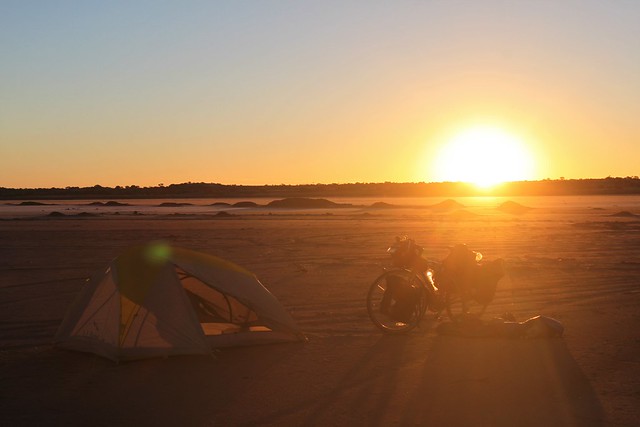
After he left another tourist came over from the bus. She wanted to know why I was doing it. I told her I was getting a free sauna. This didn’t satisfy her. She seemed really bothered by why I would push myself through this hot desert instead of sitting in an air-con bus. I was about to get my camera out to show her a picture but as I did so she started asking more silly questions about why I didn’t take a motorbike so I put the camera back in my bag. This is the picture I was going to show her, I thought it would have make it clear why I don’t want to sleep in a hotel after sitting in a bus all day but I don’t think she would have understood.
You probably will, though. The night before I’d ended an awful day in the headwind by dragging my bike onto a salt flat and pitching my tent as the wind finally dropped. It would have been a disastrous spot to camp if any rain had fallen but the sky was clear of clouds as it almost always. The flies went to bed with the last light, the temperature dropped down 15C and the stars came out to perform their nightly magic-show. The clay beneath my feet was soft. No ants out here, no snakes or scary spiders. I walked across the clay pan bare-feet under a zillion stars wondering if life could possibly get any better than this.
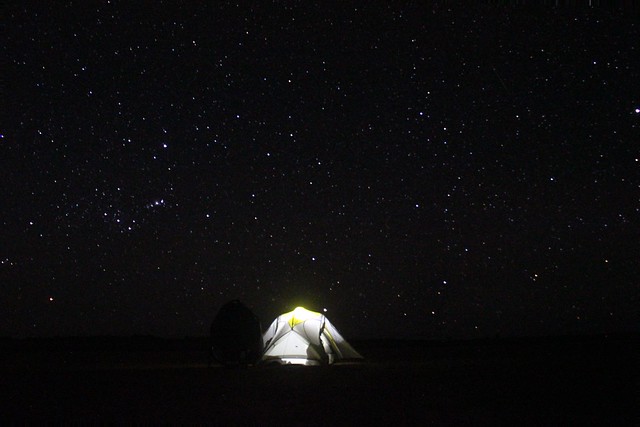
I only get a conversation or two in a day so it’s important for them to be good ones. The next morning I reached Kulgera roadhouse and paused to fix a puncture. I put my things on a dirty picnic table outside in the shade while I made the repair. The owner came out frowning:
“People eat off those tables”
“Oh, sorry. I won’t put anything dirty on them”
“You just had your tyres up on there”. I tried to think back over the last few minutes and I probably had left the tyres on it for a minute.
“Ah – sorry mate. I’ll keep them on the floor.”
“Show some respect” and then he walked off. Strange.
I went into the shop to grab the key for the bore water tap. The girl inside had been holding onto it for me while I fixed the flat. When I got inside she said “sorry, the boss has taken the key off me. He didn’t want you to take the water. He’s angry you put your tyres on the table”.
“For real?” She nodded. “What a twat”.
Confiscating the tap-key? What next – I’ll be put on the naughty step? I filled a couple bottles of foul white bore water from the toilet taps before continuing on my bike praying that the next water tanks would have some water in them. I should add that I had bought something from that roadhouse (a can of Fanta for $4!). He was one of a few people that have looked at me like a homeless-scrounger before I’ve even opened my mouth. Admittedly my clothes are covered in holes and I look like an unshaven bum but there isn’t much to look sharp for out here.
Across so much of the rest of the world everyone thought I was super rich just because of my skin colour but here it is almost the opposite because I’m on a bicycle. A security guard had caught me using the staff showers at Ayre’s Rock Resort (there was no sign saying who could/couldn’t use it). After he’d told me off he narrowed his eyes and said “there’s no camping here” as if I was about to pitch on the adjoining cricket pitch. “What, here in the toilets?”
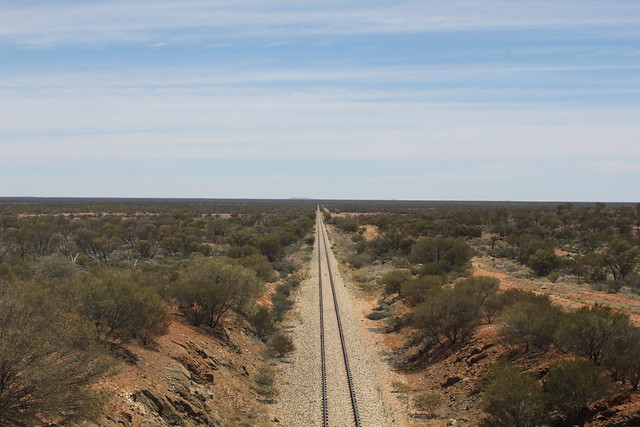
In another roadhouse I asked a bloke if I could get some ice in my thermos (I did that in many places). He paused and then said “I’ll have to charge you”
“oh OK, don’t worry.”
“Doesn’t work like that ‘round here”. Any need for that extra comment? I’d already bought a couple things of him. I told him that no one else had ever tried to charge me for a few cubes of ice and he said I’d better go to one of those places then.
These people could have easy said, “please don’t put your tyres on the table”, “would you mind not using this shower again” or “I’m afraid I’ll have to charge you for the ice as we order in the bags”. I think the desert makes people prickly out here like the plants. It’s a place for survival, not for manners. Money is survival, after all.

The landscape changed once again. There was less vegetation than ever as I cycled south along the Stuart Highway. The temperature picked up too. Some aboriginals stopped there car to take a photo of me and said they thought it was too hard to ride a car – let alone a push bike! As I posed for a pic it occurred to me how few photos of people have featured in the last three Oz blogs. I love taking pictures of people – my last posts in Indonesia and East Timor were full of faces but out here I’d feel self conscious asking an indigenous person for a photo.
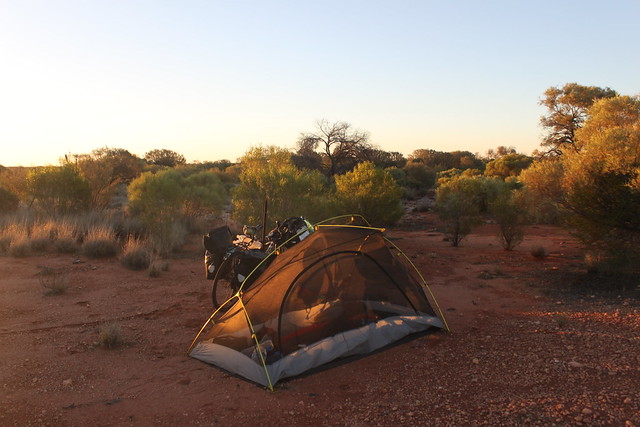
I’d finally reached the turn off for the Oodnadatta and I camped near the Marla roadhouse. I went to bed very nervous – the most remote road of my entire trip lay ahead and December was only bringing more heat to the desert.
The Oodnadatta story is one for the next blog…
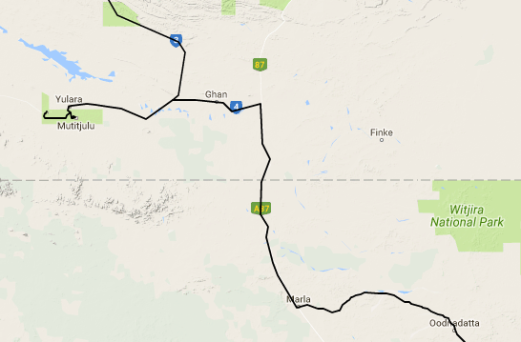
JKB I am impressed – you used the word ‘numinous’ !! Happy Cycling adrian
LikeLike
I don’t flex my lexical range that often so that when I drop a biggun they make an impression!!
LikeLike
Hi, i love reading your stories. What you are doing is amazing i think 🙂 it was my dream to reach australia as well a few years ago, i did it by plane from belgium. It’s amazing the opportunities you have when you can just take a bycicle and get there too 🙂 it makes me wonder if i would dare to do it 🙂 i think it’s very brave you’re doing this at your age and i’m sure it’s a life changing experience teaching you so much more about everything 🙂
LikeLike
Glad they are being enjoyed!
If I can do it… you certainly can too! The leap of faith is always the hardest part.
I have learnt more about the world and my place within it over the last two years than the last twenty!
LikeLiked by 1 person
Thanks and keep up the posting of articles 🙂 i love to read them 🙂
LikeLike
‘numinous’ impressed me too – I had to look it up. The sock thing does work and when I first saw ‘that’ pic it said it all for me – you were right, it would probably have been waisted on her, but maybe, just maybe, it might have . . .
Whatever. D xx
LikeLike
I’m not sure it does work if it’s 40 degrees!!
Glad I get to teach my old man some new words from the other side of the world…
LikeLike
Well, at 35c driving in the desert it did. Maybe it needs wind.
LikeLike